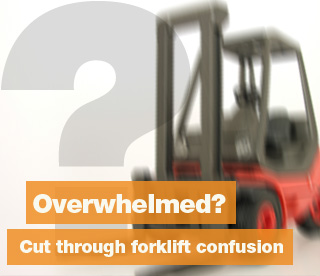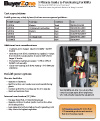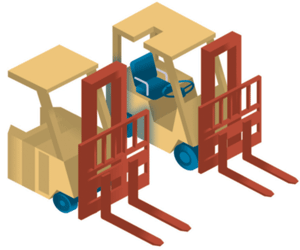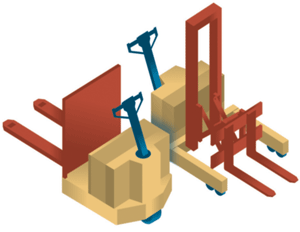A Field Guide to Forklifts

Sometimes having a large selection of products from which to choose can be a blessing. In other cases, though, it can be a curse: Too many choices!
If you're in the market for lift trucks and are feeling like a kid in a candy store, you're not alone. Plenty of warehouse managers feel this way. It takes a great deal of research into the many variations on the forklifts theme before you can logically eliminate some models from consideration. In this article, we offer some information that will help you cut through the confusion.
According to the Industrial Truck Association (ITA), there are more than 20 different types of lift trucks and more than 20 lift-truck manufacturers in the United States and Canada. The ITA represents the manufacturers of lift trucks and their suppliers who do business in the United States, Canada, and Mexico.
Want quick, valuable tips for buying forklifts?

Download our free PDF - the BuyerZone 5 Minute Guide to Purchasing Forklifts.
The ITA has organized the different types of lift trucks into eight classes:
- Class 1: Electric-Motor Rider Trucks
- Class 2: Electric-Motor Narrow-Aisle Trucks
- Class 3: Electric-Motor Hand Trucks
- Class 4: Internal-Combustion Engine Trucks-Cushion Tires
- Class 5: Internal-Combustion Engine Trucks-Pneumatic Tires
- Class 6: Electric and Internal-Combustion Engine Tow Tractors
- Class 7: Rough-Terrain Forklift Trucks
- Class 8: Personnel and Burden Carriers
Choices, Choices
The first step in selection may be to decide whether you want internal-combustion (IC) or electric trucks. Each has its advantages and disadvantages.

Left: Counterbalanced Rider, Stand-Up
Right: Counterbalanced Rider, Pneumatic or Either Type Tire, Sit-Down
Internal Combustion (Classes 4, 5, 6, 7, & 8)
These trucks, which can operate on gas, diesel, compressed natural gas, or liquid propane, are primarily used outdoors because of their emissions and because they are able to operate in inclement weather.
Propane-powered units can be used indoors, but they do emit pollutants. "Regardless of how much manufacturers tell you that propane burns clean, look at the tops of cartons in facilities that use propane trucks, and they are black from soot," observes Geoff Sisko, senior vice president for Gross & Associates, a Woodbridge, N.J., consulting company specializing in warehousing.
Benefits:
- Lower initial purchase cost (20 percent to 40 percent lower than electric)
- Quick and easy to refuel, and no need to recharge batteries
- Can be used outdoors in the rain
- Able to lift heavy loads, from 15,000 pounds to as much as 35,000 pounds.
"It is possible to produce very few emissions from IC trucks with increased catalytic-converter capabilities or fuel systems to make the machines much cleaner-burning," reports Adam Hughes, national dealer sales manager for Toyota Material Handling, which makes Class 1 through Class 6 trucks. "IC trucks will also continue to be popular where load sizes are very high-above 12,000 pounds-such as at ports, lumberyards, and heavy steel manufacturing."
Drawbacks:
- Higher cost-per-hour to operate than electric trucks because of fuel and maintenance costs
- Shorter lifespan because there are more moving parts
- Noisy operation
- Fuel-storage requirements.

Left: Low-Lift Walkie/Center Control Hand Truck
Right: Reach-Type Outrigger Hand Truck
Electric (Classes 1, 2, 3, and 6)
For the most part, these trucks are used indoors because they produce no harmful emissions.
Benefits:
- Lower cost-per-hour to operate than IC units
- Quiet operation
- No fuel-storage requirements
- Longer lifespan because there are fewer moving parts.
"The overall life-cycle cost of electric is less than IC, primarily because of fuel costs," explains Jason Dunigan, product manager for Jungheinrich Lift Truck Corp. USA, which manufactures Class 1 through Class 5 trucks. "The cost to recharge an electric truck runs from $1.50 to $4.50 per shift, while a bottle of LPG (liquid propane gas) costs $18 to $25," he says.
In addition, Dunigan says, rising diesel and LPG costs are leading customers to look for alternatives. "We are finding that customers are switching to Class 1 trucks because they can do almost everything that the Class 4 and Class 5 can do," he says.
Concerns over engine emissions and, in at least one state, compliance with the law, are also nudging buyers toward electric-motor trucks. "In California, a new law requires that certain indoor environments are not allowed to use LPG or diesel, so we are seeing a surge of customers shifting from Class 4 and 5 to Class 1," Dunigan notes.
According to Toyota's Hughes, there used to be a notable difference between electric and IC trucks' performance. "Electric trucks weren't capable of performing as well as the IC trucks in terms of lifting and traveling," he says. "However, the performance of electric trucks over the years has been improving, so I think that gap is narrowing."
Another benefit is that electric trucks can work in more confined areas, creating more storage space and saving money from a real estate standpoint. "This is even more true with AC (alternating current) motor technology because the components are smaller, allowing for the design of a more compact machine," Hughes adds.
These are some of the reasons manufacturers are seeing more interest in electric trucks. Thirty years ago, according to Hughes, the market was about 60 percent IC trucks and 40 percent electric. "Today, it's about 60 percent electric and 40 percent IC," he says.
Drawbacks:
- Higher initial purchase cost (20 percent to 40 percent higher than internal-combustion trucks)
- Slower acceleration and top speeds than IC units
- Needs a battery-charging station
- Requires about 16 hours to recharge and cool down the battery before use
- Limited load capacity (below 15,000 pounds)
- Can't be used outdoors if raining.

Top: Narrow-Aisle Order Picker
Bottom: Narrow-Aisle Low-Lift Pallet Truck
Selection Process
When it comes time to select the type of lift truck that best fits your needs, Sisko emphasizes, don't begin with the truck itself. "First, you should focus on what you're going to store, such as pipe, furniture, or cartons," he suggests. Second, figure out what kind of storage module you'll use, such as a single-deep rack, a double-deep rack, a push-back rack, or a flow-through rack.
Then you can begin to look at the various types of trucks. If, for example, you're going to be using a double-deep rack, this will limit your choice to a deep-reach truck. If you're going to be loading pipe or lumber, you will probably want a side-loader truck or four-way truck, Sisko explains.
Next, be sure you have the right aisle spacing. For a regular reach truck, you will need about a 9.5-foot-wide aisle. A deep-reach truck requires about a 10.5-foot aisle. For a counterbalanced truck, you'll need about a 12-foot aisle.
Types of Lift Trucks
There are several general types of trucks, each with its own uses, benefits, and drawbacks.
Standard Truck: Also known as a counterbalanced sit-down truck. Most of the standard trucks that are used in warehouses are in the 3,000- to 4,000-pound range and can reach up to 20 feet high.
Reach Truck: These narrow-aisle (NA) trucks are specifically designed for pallet storage. They consist of outriggers and telescoping forks that allow drivers to pick up a loads and then retract them over the outriggers. These trucks are not well-suited for loading and unloading or for moving loads quickly over distances. They are available at heights of up to 40 feet.
Motorized Pallet Truck: These are also known as "walkies," "walkie-riders," or "riders." With the walkie version, operators walk alongside the trucks as they move loads. They are useful for moving loads in small areas. With the rider version, operators stand on a small platform. They are useful for moving loads over longer distances.
Order Selector: Also known as an "order picker." These very-narrow-aisle (VNA) trucks are designed for manual handling of racked loads that are smaller than pallet size. They elevate both load and operator to the necessary height, which can be as high as 40 feet.
Swing-Mast and Turret Trucks: These two types are very-narrow-aisle (VNA) vehicles. Swing-mast trucks look like standard lift trucks but their masts can swing to a 90-degree angle in one direction only. Turret trucks are similar to order selectors in that they elevate both load and operator, but they can also swing the forks 90 degrees in either direction.
NA and VNA Trucks: As noted above, some types of trucks have narrow-aisle (NA) and very-narrow-aisle (VNA) features. Wide-aisle trucks need 11 feet or more of space for operation. NA trucks, however, can be used in spaces measuring 8 feet to 10 feet wide, and VNA trucks can operate in spaces as narrow as 6 feet wide. This is the result of their ability to turn their forks at right angles. The benefit of this feature is that these trucks make it possible for warehouses to be built with more aisles, and thus more capacity. However, their loads usually are limited to between 5,000 and 10,000 pounds.
Class Selection
If you're looking for electric trucks, there are some features that are important to know. John Colborn, marketing director for The Raymond Corporation, which manufactures Class 1, 2, and 3 trucks, explains:
Class 1 trucks do a good job of loading and unloading trailers on the dock. "You don't want to use these as transporters moving loads long distances," Colburn advises.
Class 2 trucks are appropriate for rack-interface activity, which involves putting product away and pulling it out of storage. These can either be the pallet-handling type or the order-picker (less-than-palletload) type.
Class 3 trucks are versatile because they can be used for loading and unloading trailers as well as for transporting loads, Colborn says. He says that Class 3 trucks are becoming more popular, especially in mega-warehouses, because they are being designed to transport up to four palletloads at a time.
Other Considerations
Among the other considerations for a prospective buyer is how much capacity you need. Truck capabilities range from 3,000 to 35,000 pounds, with the average being 5,000 to 8,000 pounds.
A second is height. If all you do is load and unload, you won't need as much height as you would when stocking on high warehouse shelves.
A third is whether to buy new or used. If you're only going to use the truck for a couple of hours a day, you may want to consider used equipment. But if you plan to use it for four or more hours, it makes more sense to buy new.
Finally, take into account a truck's life-cycle cost, not just its up-front cost. "If you want quality, you have to pay for it up-front," emphasizes Jungheinrich's Dunigan. "If you accept lower quality, you will end up paying more through the life of the product."
Classes and Lift Codes
Class 1: Electric-Motor Rider Trucks
- Lift Code 1: Counterbalanced Rider Type (Stand-up)
- Code 4: Three-Wheel Electric Truck (Sit-down)
- Code 5: Counterbalanced Rider Type (Cushion Tires, Sit-down)
- Code 6: Counterbalanced Rider Type (Pneumatic or Cushion Tire, Sit-down)
Class 2: Electric-Motor Narrow-Aisle Trucks
- Lift Code 1: High-Lift Straddle
- Code 2: Order Picker
- Code 3: Reach-Type Outrigger
- Code 4: Side Loaders, Turret Trucks, Swing-Mast, and Convertible Turret/Stock Pickers
- Code 6: Low-Lift Pallet and Platform (Rider)
Class 3: Electric-Motor Hand Trucks
- Lift Code 1: Low-Lift Platform
- Code 2: Low-Lift Walkie Pallet
- Code 3: Tractors (Draw-Bar Pull, Under 999 lbs.)
- Code 4: Low-Lift Walkie (Center Control)
- Code 5: Reach-Type Outrigger
- Code 6: High-Lift Straddle
- Code 7: High-Lift Counterbalanced
- Code 8: Low-Lift Walker/Rider Pallet
Class 4: Internal-Combustion Engine Trucks - Cushion Tires
- Lift Code 3: Fork, Counterbalanced
Class 5: Internal-Combustion Engine Trucks - Pneumatic Tires
- Lift Code 4: Fork, Counterbalanced
Class 6: Electric and Internal-Combustion Engine Tow Tractors
- Lift Code 1: Sit-Down Rider (Draw-Bar Pull, Over 999 lbs.)
Class 7: Rough-Terrain Forklift Trucks
- Lift Code 1: All Rough-Terrain Lift Trucks
Class 8: Personnel and Burden Carriers
- Lift Code 1: All Personnel and Burden Carriers
Source: Industrial Truck Association.
Diagrams showing examples of each class and lift code can be found at the Industrial Truck Association's website.

Logistics Management is a magazine that covers supply chain management, transportation, logistics and distribution of materials, products and equipment. Coverage includes logistics and supply chain technology and international transportation.